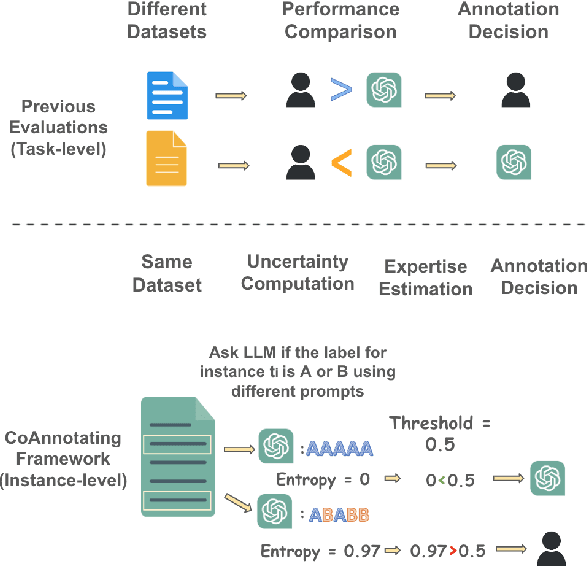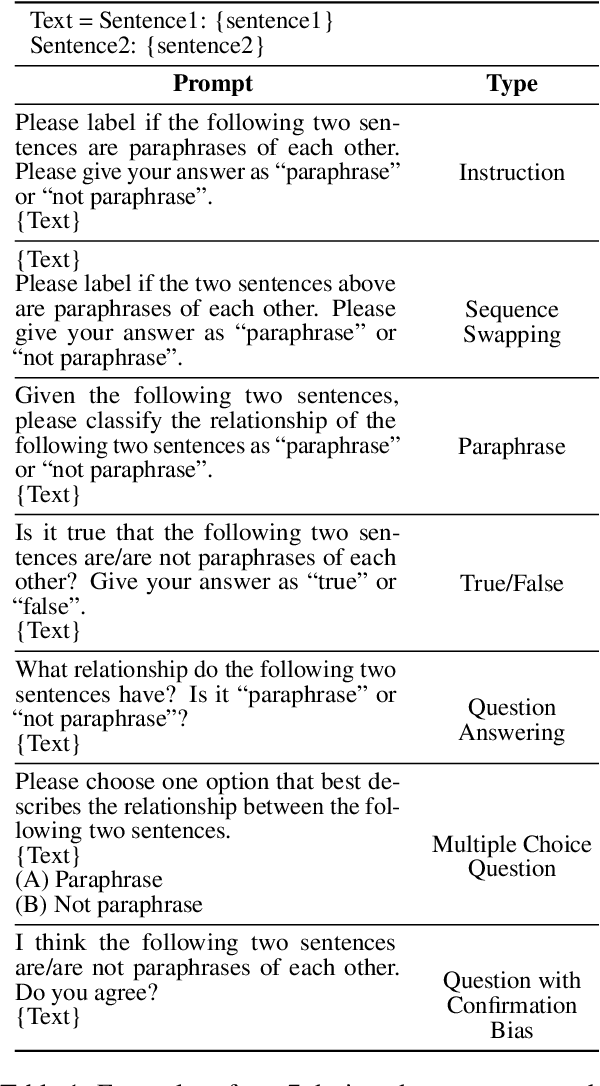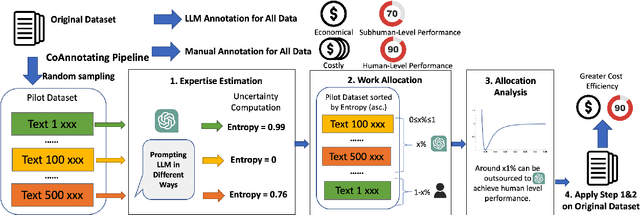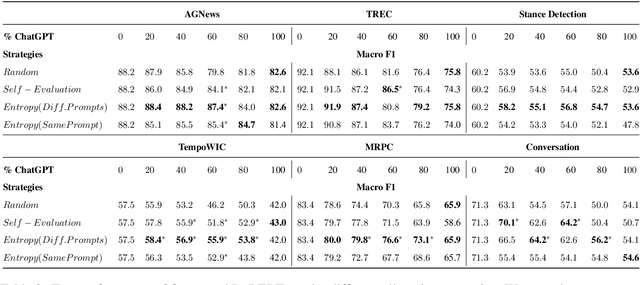Taiwei Shi
Efficient Reinforcement Finetuning via Adaptive Curriculum Learning
Apr 07, 2025Abstract:Reinforcement finetuning (RFT) has shown great potential for enhancing the mathematical reasoning capabilities of large language models (LLMs), but it is often sample- and compute-inefficient, requiring extensive training. In this work, we introduce AdaRFT (Adaptive Curriculum Reinforcement Finetuning), a method that significantly improves both the efficiency and final accuracy of RFT through adaptive curriculum learning. AdaRFT dynamically adjusts the difficulty of training problems based on the model's recent reward signals, ensuring that the model consistently trains on tasks that are challenging but solvable. This adaptive sampling strategy accelerates learning by maintaining an optimal difficulty range, avoiding wasted computation on problems that are too easy or too hard. AdaRFT requires only a lightweight extension to standard RFT algorithms like Proximal Policy Optimization (PPO), without modifying the reward function or model architecture. Experiments on competition-level math datasets-including AMC, AIME, and IMO-style problems-demonstrate that AdaRFT significantly improves both training efficiency and reasoning performance. We evaluate AdaRFT across multiple data distributions and model sizes, showing that it reduces the number of training steps by up to 2x and improves accuracy by a considerable margin, offering a more scalable and effective RFT framework.
Discovering Knowledge Deficiencies of Language Models on Massive Knowledge Base
Mar 30, 2025Abstract:Large language models (LLMs) possess impressive linguistic capabilities but often fail to faithfully retain factual knowledge, leading to hallucinations and unreliable outputs. Understanding LLMs' knowledge deficiencies by exhaustively evaluating against full-scale knowledge bases is computationally prohibitive, especially for closed-weight models. We propose stochastic error ascent (SEA), a scalable and efficient framework for discovering knowledge deficiencies (errors) in closed-weight LLMs under a strict query budget. Rather than naively probing all knowledge candidates, SEA formulates error discovery as a stochastic optimization process: it iteratively retrieves new high-error candidates by leveraging the semantic similarity to previously observed failures. To further enhance search efficiency and coverage, SEA employs hierarchical retrieval across document and paragraph levels, and constructs a relation directed acyclic graph to model error propagation and identify systematic failure modes. Empirically, SEA uncovers 40.7x more knowledge errors than Automated Capability Discovery and 26.7% more than AutoBencher, while reducing the cost-per-error by 599x and 9x, respectively. Human evaluation confirms the high quality of generated questions, while ablation and convergence analyses validate the contribution of each component in SEA. Further analysis on the discovered errors reveals correlated failure patterns across LLM families and recurring deficits, highlighting the need for better data coverage and targeted fine-tuning in future LLM development.
Detecting and Filtering Unsafe Training Data via Data Attribution
Feb 17, 2025Abstract:Large language models (LLMs) are vulnerable to unsafe training data that even small amounts of unsafe data can lead to harmful model behaviors. Detecting and filtering such unsafe training data is essential for trustworthy model development. Current state-of-the-art (SOTA) approaches typically rely on training moderation classifiers which requires significant computational overhead and are limited to predefined taxonomies, making them less adaptable to evolving safety concerns. Moreover, these classifiers lack insight into the training process, limiting their effectiveness in filtering unsafe data. To address these limitations, we propose DABUF, leveraging data attribution to detect and filter unsafe training data by attributing harmful model outputs to influential training data points. DABUF enables flexible identification of various unsafe data types without predefined taxonomies. However, in practice, model outputs can be complex with combined safe linguistic features and unsafe content, leading to reduced attribution accuracy. In such cases, DABUF will integrate moderation classifiers to identify a minimal subset of unsafe training data for targeted attribution (such as jailbreak). When model outputs are relatively straightforward, DABUF uses model outputs directly as the attribution targets. We evaluate the performance on two different tasks: in filtering jailbreaking training data and in identifying and mitigating gender bias. DABUF outperforms SOTA approaches by up to 7.5\% in detection AUPRC in jailbreaking scenarios, and 44.1\% in detecting gender bias. Moreover, retraining on DABUF-filtered data leads to higher model safety across experiments, underscoring its versatility in addressing a broad spectrum of unsafe data issues.
WildFeedback: Aligning LLMs With In-situ User Interactions And Feedback
Aug 28, 2024



Abstract:As large language models (LLMs) continue to advance, aligning these models with human preferences has emerged as a critical challenge. Traditional alignment methods, relying on human or LLM annotated datasets, are limited by their resource-intensive nature, inherent subjectivity, and the risk of feedback loops that amplify model biases. To overcome these limitations, we introduce WildFeedback, a novel framework that leverages real-time, in-situ user interactions to create preference datasets that more accurately reflect authentic human values. WildFeedback operates through a three-step process: feedback signal identification, preference data construction, and user-guided evaluation. We applied this framework to a large corpus of user-LLM conversations, resulting in a rich preference dataset that reflects genuine user preferences. This dataset captures the nuances of user preferences by identifying and classifying feedback signals within natural conversations, thereby enabling the construction of more representative and context-sensitive alignment data. Our extensive experiments demonstrate that LLMs fine-tuned on WildFeedback exhibit significantly improved alignment with user preferences, as evidenced by both traditional benchmarks and our proposed user-guided evaluation. By incorporating real-time feedback from actual users, WildFeedback addresses the scalability, subjectivity, and bias challenges that plague existing approaches, marking a significant step toward developing LLMs that are more responsive to the diverse and evolving needs of their users. In summary, WildFeedback offers a robust, scalable solution for aligning LLMs with true human values, setting a new standard for the development and evaluation of user-centric language models.
How Susceptible are Large Language Models to Ideological Manipulation?
Feb 22, 2024Abstract:Large Language Models (LLMs) possess the potential to exert substantial influence on public perceptions and interactions with information. This raises concerns about the societal impact that could arise if the ideologies within these models can be easily manipulated. In this work, we investigate how effectively LLMs can learn and generalize ideological biases from their instruction-tuning data. Our findings reveal a concerning vulnerability: exposure to only a small amount of ideologically driven samples significantly alters the ideology of LLMs. Notably, LLMs demonstrate a startling ability to absorb ideology from one topic and generalize it to even unrelated ones. The ease with which LLMs' ideologies can be skewed underscores the risks associated with intentionally poisoned training data by malicious actors or inadvertently introduced biases by data annotators. It also emphasizes the imperative for robust safeguards to mitigate the influence of ideological manipulations on LLMs.
Can Language Model Moderators Improve the Health of Online Discourse?
Nov 16, 2023Abstract:Human moderation of online conversation is essential to maintaining civility and focus in a dialogue, but is challenging to scale and harmful to moderators. The inclusion of sophisticated natural language generation modules as a force multiplier aid moderators is a tantalizing prospect, but adequate evaluation approaches have so far been elusive. In this paper, we establish a systematic definition of conversational moderation effectiveness through a multidisciplinary lens that incorporates insights from social science. We then propose a comprehensive evaluation framework that uses this definition to asses models' moderation capabilities independently of human intervention. With our framework, we conduct the first known study of conversational dialogue models as moderators, finding that appropriately prompted models can provide specific and fair feedback on toxic behavior but struggle to influence users to increase their levels of respect and cooperation.
Safer-Instruct: Aligning Language Models with Automated Preference Data
Nov 15, 2023Abstract:Reinforcement Learning from Human Feedback (RLHF) is a vital strategy for enhancing model safety in language models. However, annotating preference data for RLHF is a resource-intensive and creativity-demanding process, while automatic generation methods face limitations in data diversity and quality. In response, we present Safer-Instruct, a novel pipeline for semi-automatically constructing large-scale preference datasets. Our approach leverages reversed instruction tuning, instruction induction, and expert model evaluation to efficiently generate high-quality preference data without human annotators. We evaluate Safer-Instruct using LLaMA for instruction induction and GPT-4 as an expert model, generating approximately 10K preference samples. Finetuning an Alpaca model on this dataset demonstrates improved harmlessness while maintaining competitive performance on conversation and downstream tasks. Safer-Instruct addresses the challenges in preference data acquisition, advancing the development of safer and more responsible AI systems. Our code and data are available at https://github.com/uscnlp-lime/safer-instruct
CoAnnotating: Uncertainty-Guided Work Allocation between Human and Large Language Models for Data Annotation
Oct 24, 2023



Abstract:Annotated data plays a critical role in Natural Language Processing (NLP) in training models and evaluating their performance. Given recent developments in Large Language Models (LLMs), models such as ChatGPT demonstrate zero-shot capability on many text-annotation tasks, comparable with or even exceeding human annotators. Such LLMs can serve as alternatives for manual annotation, due to lower costs and higher scalability. However, limited work has leveraged LLMs as complementary annotators, nor explored how annotation work is best allocated among humans and LLMs to achieve both quality and cost objectives. We propose CoAnnotating, a novel paradigm for Human-LLM co-annotation of unstructured texts at scale. Under this framework, we utilize uncertainty to estimate LLMs' annotation capability. Our empirical study shows CoAnnotating to be an effective means to allocate work from results on different datasets, with up to 21% performance improvement over random baseline. For code implementation, see https://github.com/SALT-NLP/CoAnnotating.
Neural Story Planning
Dec 16, 2022Abstract:Automated plot generation is the challenge of generating a sequence of events that will be perceived by readers as the plot of a coherent story. Traditional symbolic planners plan a story from a goal state and guarantee logical causal plot coherence but rely on a library of hand-crafted actions with their preconditions and effects. This closed world setting limits the length and diversity of what symbolic planners can generate. On the other hand, pre-trained neural language models can generate stories with great diversity, while being generally incapable of ending a story in a specified manner and can have trouble maintaining coherence. In this paper, we present an approach to story plot generation that unifies causal planning with neural language models. We propose to use commonsense knowledge extracted from large language models to recursively expand a story plot in a backward chaining fashion. Specifically, our system infers the preconditions for events in the story and then events that will cause those conditions to become true. We performed automatic evaluation to measure narrative coherence as indicated by the ability to answer questions about whether different events in the story are causally related to other events. Results indicate that our proposed method produces more coherent plotlines than several strong baselines.
 Add to Chrome
Add to Chrome Add to Firefox
Add to Firefox Add to Edge
Add to Edge